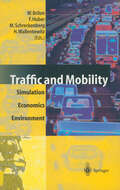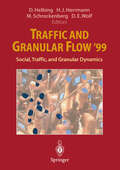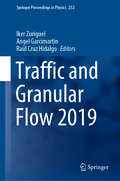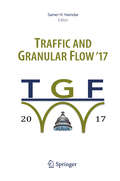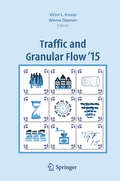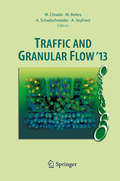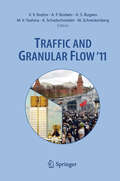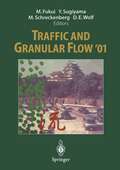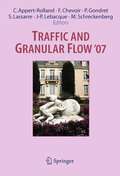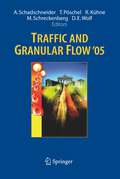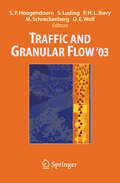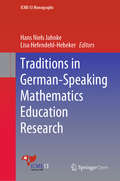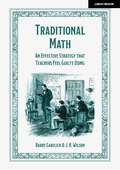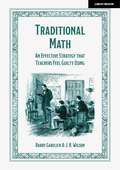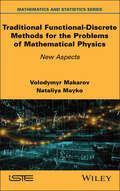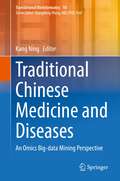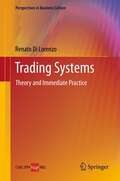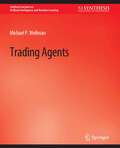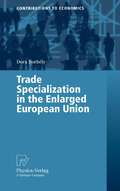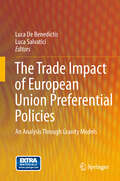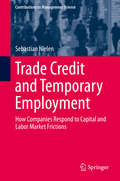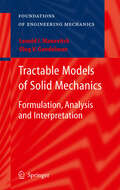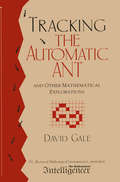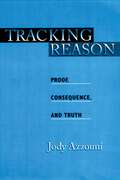- Table View
- List View
Traffic and Mobility: Simulation — Economics — Environment
by Werner Brilon Felix Huber Michael Schreckenberg Henning WallentowitzAnyone who reflects on the future of society cannot do so without at the same time thinking about the future of our transportation systems. The dilemma is obvious. On the one hand, mobility must be maintained as it is crucial to economic development and because people are eager for individual mobility. On the other hand, traffic imposes heavy burdens on people and on the environment, on cities and communities and on our national economies. Finding a solution to that dilemma seems to be difficult, in fact we have not even developed a rough idea of how it could look like. This is why the North Rhine-Westphalia Science and Research Ministry came up with the plan to work out a well-founded scientific basis on which to solve the problems inherent in our transport system. A research network has been established and sponsored with government funds for a period of three years with a view to realising that objective. The "Traffic Simulation and Environmental Impact" research network is composed of researchers who have an excellent reputation as North Rhine-Westphalia traffic experts. Cutting across various disciplines of knowledge, the network aims to integrate transportation and natural sciences, particularly physics and mathematics, in a move to profit by the synergy between technical know-how and innovative methodology. The present volume is intended as a progress report and a prologue to the forthcoming international colloquium which represents the highlight and at the same time the end of the three-year project funding period.
Traffic and Granular Flow ’99: Social, Traffic, and Granular Dynamics
by D. Helbing H. J. Herrmann M. Schreckenberg D. E. Wolf"Are there common phenomena and laws in the dynamic behavior of granular materials, traffic, and socio-economic systems?" The answers given at the international workshop "Traffic and Granular Flow '99" are presented in this volume. From a physical standpoint, all these systems can be treated as (self)-driven many-particle systems with strong fluctuations, showing multistability, phase transitions, non-linear waves, etc. The great interest in these systems is due to several unexpected new discoveries and their practical relevance for solving some fundamental problems of today's societies. This includes intelligent measures for traffic flow optimization and methods from "econophysics" for stabilizing (stock) markets.
Traffic and Granular Flow 2019 (Springer Proceedings in Physics #252)
by Iker Zuriguel Angel Garcimartín Raúl Cruz HidalgoThis book gathers contributions on a variety of flowing collective systems. While primarily focusing on pedestrian dynamics, they also reflect the latest developments in areas such as vehicular traffic and granular flows and address related emerging topics such as self-propelled particles, data transport, swarm behavior, intercellular transport, and collective dynamics of biological systems. Combining fundamental research and practical applications in the various fields discussed, the book offers a valuable asset for researchers and practitioners alike.
Traffic and Granular Flow '17
by Samer H. HamdarThis book presents 57 peer-reviewed papers from the 12th Conference on Traffic and Granular Flow (TGF) held in Washington, DC, in July 2017. It offers a unique synthesis of the latest scientific findings made by researchers from different countries, institutions and disciplines.The research fields covered range from physics, computer science and engineering and they may be all grouped under the topic of "Traffic and Granular Flow". The main theme of the Conference was: "From Molecular Interactions to Internet of Things and Smart Cities: The Role of Technology in the Understanding and the Evolution of Particle Dynamics".
Traffic and Granular Flow '15
by Victor L. Knoop Winnie DaamenThe Conference on Traffic and Granular Flow brings together international researchers from different fields ranging from physics to computer science and engineering to discuss the latest developments in traffic-related systems. Originally conceived to facilitate new ideas by considering the similarities of traffic and granular flow, TGF'15, organised by Delft University of Technology, now covers a broad range of topics related to driven particle and transport systems. Besides the classical topics of granular flow and highway traffic, its scope includes data transport (Internet traffic), pedestrian and evacuation dynamics, intercellular transport, swarm behaviour and the collective dynamics of other biological systems. Recent advances in modelling, computer simulation and phenomenology are presented, and prospects for applications, for example to traffic control, are discussed. The conference explores the interrelations between the above-mentioned fields and offers the opportunity to stimulate interdisciplinary research, exchange ideas, and meet many experts in these areas of research.
Traffic and Granular Flow '13
by Mohcine Chraibi Maik Boltes Andreas Schadschneider Armin SeyfriedThis book continues the biannual series of conference proceedings, which has become a classical reference resource in traffic and granular research alike, and addresses the latest developments at the intersection of physics, engineering and computational science. These involve complex systems, in which multiple simple agents, be they vehicles or particles, give rise to surprising and fascinating phenomena.The contributions collected in these proceedings cover several research fields, all of which deal with transport. Topics include highway, pedestrian and internet traffic; granular matter; biological transport; transport networks; data acquisition; data analysis and technological applications. Different perspectives, i.e., modeling, simulations, experiments, and phenomenological observations are considered.
Traffic and Granular Flow '11
by Valery V. Kozlov, Alexander P. Buslaev, Alexander S. Bugaev, Marina V. Yashina, Andreas Schadschneider and Michael SchreckenbergThis book continues the biannual series of conference proceedings, which has become a classical reference resource in traffic and granular research alike. It addresses new developments at the interface between physics, engineering and computational science. Complex systems, where many simple agents, be they vehicles or particles, give rise to surprising and fascinating phenomena. The contributions collected in these proceedings cover several research fields, all of which deal with transport. Topics include highway, pedestrian and internet traffic, granular matter, biological transport, transport networks, data acquisition, data analysis and technological applications. Different perspectives, i.e. modeling, simulations, experiments and phenomenological observations, are considered.
Traffic and Granular Flow ’01
by Minoru Fukui Yuki Sugiyama Michael Schreckenberg Dietrich E. WolfDuring the last decade physicists, engineers and computer scientists have joined in an enormously fruitful dialogue about traffic and granular flow. Cars and sand grains have in common, that they interact irreversibly, which is the reason for similar jamming phenomena. The main difference is that car drivers choose their destination and route individually, while grains follow external driving forces. This book gives an overview about the progress in modelling, computer simulation, experiments and field observations, which was reached within the last two years. The contributions are based on the International Workshop Traffic and Granular Flow '01, which took place in Nagoya, 15 - 17 October 2001. Topics include a critical classification of models for highway traffic, new technological applications, friction and arching phenomena in pedestrian traffic, scale free networks and internet traffic, instabilities and fluctuations in avalanches and granular pipe flow.
Traffic and Granular Flow ' 07
by François Chevoir Philippe Gondret Sylvain Lassarre Jean-Patrick Lebacque Michael Schreckenberg Cécile Appert-RollandTraffic and Granular Flow ' 05
by Andreas Schadschneider Thorsten Pöschel Reinhart Kühne Michael Schreckenberg Dietrich E. WolfThis book again continues the biannual series of (now six) conference proceedings, which has become a classical reference in traffic and granular research alike. It addresses new developments at the borderline between physics, engineering and computational science. Complex systems, where many simple agents, be it vehicles or particles, give rise to surprising and fascinating phenomena.
Traffic and Granular Flow ' 03
by Michael Schreckenberg Dietrich E. Wolf Serge P. Hoogendoorn Stefan Luding Piet H. L. BovyThese proceedings are the fifth in the series Traffic and Granular Flow, and we hope they will be as useful a reference as their predecessors. Both the realistic modelling of granular media and traffic flow present important challenges at the borderline between physics and engineering, and enormous progress has been made since 1995, when this series started. Still the research on these topics is thriving, so that this book again contains many new results. Some highlights addressed at this conference were the influence of long range electric and magnetic forces and ambient fluids on granular media, new precise traffic measurements, and experiments on the complex decision making of drivers. No doubt the “hot topics” addressed in granular matter research have diverged from those in traffic since the days when the obvious analogies between traffic jams on highways and dissipative clustering in granular flow intrigued both c- munities alike. However, now just this diversity became a stimulating feature of the conference. Many of us feel that our joint interest in complex systems, where many simple agents, be it vehicles or particles, give rise to surprising and fascin- ing phenomena, is ample justification for bringing these communities together: Traffic and Granular Flow has fostered cooperation and friendship across the scientific disciplines.
Traditions in German-Speaking Mathematics Education Research (ICME-13 Monographs)
by Hans Niels Jahnke Lisa Hefendehl-HebekerThis open access book shares revealing insights into the development of mathematics education research in Germany from 1976 (ICME 3 in Karlsruhe) to 2016 (ICME 13 in Hamburg). How did mathematics education research evolve in the course of these four decades? Which ideas and people were most influential, and how did German research interact with the international community? These questions are answered by scholars from a range of fields and in ten thematic sections: (1) a short survey of the development of educational research on mathematics in German speaking countries (2) subject-matter didactics, (3) design science and design research, (4) modelling, (5) mathematics and Bildung 1810 to 1850, (6) Allgemeinbildung, Mathematical Literacy, and Competence Orientation (7) theory traditions, (8) classroom studies, (9) educational research and (10) large-scale studies. During the time span presented here, profound changes took place in German-speaking mathematics education research. Besides the traditional fields of activity like subject-matter didactics or design science, completely new areas also emerged, which are characterized by various empirical approaches and a closer connection to psychology, sociology, epistemology and general education research. Each chapter presents a respective area of mathematics education in Germany and analyzes its relevance for the development of the research community, not only with regard to research findings and methods but also in terms of interaction with the educational system. One of the central aspects in all chapters concerns the constant efforts to find common ground between mathematics and education. In addition, readers can benefit from this analysis by comparing the development shown here with the mathematical education research situation in their own country.
Traditional Math: An effective strategy that teachers feel guilty using
by Barry Garelick J. R. Wilson"Despite experiencing our teaching in different times, we are both oriented to traditional math teaching. It wasn't because we were both taught that way, as some may believe, but because that method worked for us and we have seen it work for our students. It is efficient, effective, non-confusing and helped our students develop mathematical reasoning, understanding, and confidence. Most importantly it helped them to be successful." So begins the book on traditional math, which provides a glimpse of what explicit instruction looks like in the classroom for grades K through 8. Barry Garelick and J.R. Wilson are retired math teachers who describe the methods of traditionally taught math that they used in their teaching. Their descriptions serve two purposes: 1) It provides assurance to teachers who may already practice these methods that they are not alone, and 2) For others, it may provide some new ideas.
Traditional Math: An effective strategy that teachers feel guilty using
by Barry Garelick J. R. Wilson"Despite experiencing our teaching in different times, we are both oriented to traditional math teaching. It wasn't because we were both taught that way, as some may believe, but because that method worked for us and we have seen it work for our students. It is efficient, effective, non-confusing and helped our students develop mathematical reasoning, understanding, and confidence. Most importantly it helped them to be successful." So begins the book on traditional math, which provides a glimpse of what explicit instruction looks like in the classroom for grades K through 8. Barry Garelick and J.R. Wilson are retired math teachers who describe the methods of traditionally taught math that they used in their teaching. Their descriptions serve two purposes: 1) It provides assurance to teachers who may already practice these methods that they are not alone, and 2) For others, it may provide some new ideas.
Traditional Functional-Discrete Methods for the Problems of Mathematical Physics: New Aspects
by Volodymyr Makarov Nataliya MaykoThis book is devoted to the construction and study of approximate methods for solving mathematical physics problems in canonical domains. It focuses on obtaining weighted a priori estimates of the accuracy of these methods while also considering the influence of boundary and initial conditions. This influence is quantified by means of suitable weight functions that characterize the distance of an inner point to the boundary of the domain. New results are presented on boundary and initial effects for the finite difference method for elliptic and parabolic equations, mesh schemes for equations with fractional derivatives, and the Cayley transform method for abstract differential equations in Hilbert and Banach spaces. Due to their universality and convenient implementation, the algorithms discussed throughout can be used to solve a wide range of actual problems in science and technology. The book is intended for scientists, university teachers, and graduate and postgraduate students who specialize in the field of numerical analysis.
Traditional Functional-Discrete Methods for the Problems of Mathematical Physics: New Aspects
by Volodymyr Makarov Nataliya MaykoThis book is devoted to the construction and study of approximate methods for solving mathematical physics problems in canonical domains. It focuses on obtaining weighted a priori estimates of the accuracy of these methods while also considering the influence of boundary and initial conditions. This influence is quantified by means of suitable weight functions that characterize the distance of an inner point to the boundary of the domain. New results are presented on boundary and initial effects for the finite difference method for elliptic and parabolic equations, mesh schemes for equations with fractional derivatives, and the Cayley transform method for abstract differential equations in Hilbert and Banach spaces. Due to their universality and convenient implementation, the algorithms discussed throughout can be used to solve a wide range of actual problems in science and technology. The book is intended for scientists, university teachers, and graduate and postgraduate students who specialize in the field of numerical analysis.
Traditional Chinese Medicine and Diseases: An Omics Big-data Mining Perspective (Translational Bioinformatics #18)
by Kang NingThis book focuses on the multi-omics big-data integration, the data-mining techniques and the cutting-edge omics researches in principles and applications for a deep understanding of Traditional Chinese Medicine (TCM) and diseases from the following aspects: (1) Basics about multi-omics data and analytical methods for TCM and diseases. (2) The needs of omics studies in TCM researches, and the basic background of omics research in TCM and disease. (3) Better understanding of the multi-omics big-data integration techniques. (4) Better understanding of the multi-omics big-data mining techniques, as well as with different applications, for most insights from these omics data for TCM and disease researches. (5) TCM preparation quality control for checking both prescribed and unexpected ingredients including biological and chemical ingredients. (6) TCM preparation source tracking. (7) TCM preparation network pharmacology analysis. (8) TCM analysis data resources, web services, and visualizations. (9) TCM geoherbalism examination and authentic TCM identification. Traditional Chinese Medicine has been in existence for several thousands of years, and only in recent tens of years have we realized that the researches on TCM could be profoundly boosted by the omics technologies. Devised as a book on TCM and disease researches in the omics age, this book has put the focus on data integration and data mining methods for multi-omics researches, which will be explained in detail and with supportive examples the “What”, “Why” and “How” of omics on TCM related researches. It is an attempt to bridge the gap between TCM related multi-omics big data, and the data-mining techniques, for best practice of contemporary bioinformatics and in-depth insights on the TCM related questions.
Trading Systems: Theory and Immediate Practice (Perspectives in Business Culture)
by Renato Di LorenzoFor years, systems theory has been applied successfully in all fields of technology, but its impact on the world of finance has to date been limited. This book aims to rectify this situation. Readers will no longer be able to assert that money cannot be reliably earned on the financial markets: one might just as well say that man has never set foot on the moon. The potential reader may be frightened by the number of formulas, but can be reassured that almost all of them can be skipped. What makes the miracle of guaranteed trading success possible are the worksheets and the codes for Internet platforms which provide (at a click) functions that once had to be built with great difficulty. These worksheets and codes will be sent free of charge to anyone who requests them from the author (renato.dilorenzo1@gmail.com) as long as the request is accompanied by proof of purchase of the book, such as a photograph of the receipt taken on a mobile phone.
Trading Agents (Synthesis Lectures on Artificial Intelligence and Machine Learning)
by Michael ThomazAutomated trading in electronic markets is one of the most common and consequential applications of autonomous software agents. Design of effective trading strategies requires thorough understanding of how market mechanisms operate, and appreciation of strategic issues that commonly manifest in trading scenarios. Drawing on research in auction theory and artificial intelligence, this book presents core principles of strategic reasoning that apply to market situations. The author illustrates trading strategy choices through examples of concrete market environments, such as eBay, as well as abstract market models defined by configurations of auctions and traders. Techniques for addressing these choices constitute essential building blocks for the design of trading strategies for rich market applications. The lecture assumes no prior background in game theory or auction theory, or artificial intelligence. Table of Contents: Introduction / Example: Bidding on eBay / Auction Fundamentals / Continuous Double Auctions / Interdependent Markets / Conclusion
Trade Specialization in the Enlarged European Union (Contributions to Economics)
by Dora BorbélyThis study analyzes trade specialization patterns in the enlarged European Union with a special focus on the new EU member states and the cohesion countries. Empirical findings on revealed comparative advantage and a broader picture of competitiveness on the single market are presented from a sectoral trade point of view. Further, the author analyzes whether trade specialization patterns converge within the enlarged EU.
The Trade Impact of European Union Preferential Policies: An Analysis Through Gravity Models
by Luca De Benedictis and Luca SalvaticiThe book investigates the EU preferential trade policy and, in particular, the impact it had on trade flows from developing countries. It shows that the capability of the "trade as aid" model to deliver its expected benefits to these countries crucially differs between preferential schemes and sectors. The book takes an eclectic but rigorous approach to the econometric analysis by combining different specifications of the gravity model. An in-depth presentation of the gravity model is also included, providing significant insights into the distinctive features of this technique and its state-of-art implementation. The evidence produced in the book is extensively applied to the analysis of the EU preferential policies with substantial suggestions for future improvement. Additional electronic material to replicate the book's analysis (datasets and Gams and Stata 9.0 routines) can be found in the Extra Materials menu on the website of the book.
Trade Credit and Temporary Employment: How Companies Respond to Capital and Labor Market Frictions (Contributions to Management Science)
by Sebastian NielenThis book presents an empirical investigation into the relationship between companies' short-term response to capital and labor market frictions and performance. Two different kinds of performance measures are considered, namely innovation performance and firm performance. The author focuses on two major topics: first, on the relation between innovation performance and the use of trade credit. Second, on the relation between firm performance and the use of temporary employment. The use of in-depth firm-level data and state-of-the-art microeconometric methods provide the scientific rigor to this important investigation to answer the questions currently being confronted by many companies in different economies.
Tractable Models of Solid Mechanics: Formulation, Analysis and Interpretation (Foundations of Engineering Mechanics)
by Oleg V. Gendelman Leonid I. ManevitchThis book describes significant tractable models used in solid mechanics - classical models used in modern mechanics as well as new ones. The models are selected to illustrate the main ideas which allow scientists to describe complicated effects in a simple manner and to clarify basic notations of solid mechanics. A model is considered to be tractable if it is based on clear physical assumptions which allow the selection of significant effects and relatively simple mathematical formulations. The first part of the book briefly reviews classical tractable models for a simple description of complex effects developed from the 18th to the 20th century and widely used in modern mechanics. The second part describes systematically the new tractable models used today for the treatment of increasingly complex mechanical objects – from systems with two degrees of freedom to three-dimensional continuous objects.
Tracking the Automatic ANT: And Other Mathematical Explorations
by David GaleFor those fascinated by the abstract universe of mathematics, David Gale's columns in "The Mathematical Intelligencer" have been a prime source of entertainment, and here his columns are collected for the first time in book form. Encouraged by the magazine's editor, Sheldon Axler, to write on whatever pleased him, Gale ranged far and wide across the field of mathematics, frequently returning to favorite themes: triangles, tilings, games and paradoxes, as well as the particular automaton that gives this collection its title, the "automatic ant." Suitable for everyone having some familiarity with mathematical ideas.
Tracking Reason: Proof, Consequence, and Truth
by Jody AzzouniWhen ordinary people--mathematicians among them--take something to follow (deductively) from something else, they are exposing the backbone of our self-ascribed ability to reason. Jody Azzouni investigates the connection between that ordinary notion of consequence and the formal analogues invented by logicians. One claim of the book is that, despite our apparent intuitive grasp of consequence, we do not introspect rules by which we reason, nor do we grasp the scope and range of the domain, as it were, of our reasoning. This point is illustrated with a close analysis of a paradigmatic case of ordinary reasoning: mathematical proof.
